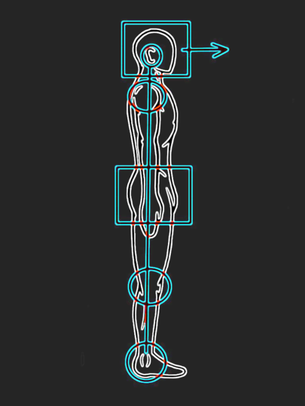Ideal posture
A syndrom is a tree that hides the forest. By principle, the Postural Transformation method envisage the whole body and aims at finding the key imbalances that, once corrected, release the proper alignement of segment and proper functioning of your tissues.
This section aims at clarifying the stakes of a whole body view and grounding the need for a personal approach.
This section aims at clarifying the stakes of a whole body view and grounding the need for a personal approach.

"Erect" posture: the posture when standing with "attention" or when told to "stand up straight". One can hold an erect posture disregarding the proper motor control or the postural muscles. But usually does not maintain it...
Postural muscles are muscles designed to hold you straight (slow twiched fibers): they rarely fatigue, nor require mental control.
Functional muscles, on the opposite, are actionable by will and can develop substancial force quickly but tire rapidly. With their tireness comes disconfort, soreness sensations.
In the left picture, a plumb line falls through the ear lob, the tip of the shoulder, center of the hip, and anterior to the knee and ankle joints
Usually, to hold this posture, one needs conscious control.
Postural muscles are muscles designed to hold you straight (slow twiched fibers): they rarely fatigue, nor require mental control.
Functional muscles, on the opposite, are actionable by will and can develop substancial force quickly but tire rapidly. With their tireness comes disconfort, soreness sensations.
In the left picture, a plumb line falls through the ear lob, the tip of the shoulder, center of the hip, and anterior to the knee and ankle joints
Usually, to hold this posture, one needs conscious control.
"Natural" posture - non vonlontary
The name of the game is to have your body to respect these alignments without using "mental will": use of postural muscles as opposed to functional muscles.
To acheive this, typical recipies are:
The name of the game is to have your body to respect these alignments without using "mental will": use of postural muscles as opposed to functional muscles.
To acheive this, typical recipies are:
- Muscle training (fitness room style or phyisotherapist exercise prescription or Pilate or Gyrotonic or Cross fit training or Caelestenic, etc)
- Neuro motor training (more complex view opposed to the strict muscle force paradigm), opening options of softer and more global exercises
- and namely the notion of cueing
- and the "imagination" (metaphors that guide movement)
- Myo-fascial massages aiming at lengthening tissues, undoing some connective tissues, etc
- Body awareness (incl. proprioception)
Transitioning from "erect posture" to "natural posture"

The process to get to a natural posture is typically as follow:
When put, for the first time since long, in a correct alignement, my patients usually complain of the unnatural feeling that it gives. It is all but normal.
Some body awareness principles/ tools are needed here:
Through the treatment, small changes in tissue, motor control & proprioception will add up to result in a new posture. Putting my patients back into their usual posture gives usually the comment "it now feels wrong, the way I was standing before".
When put, for the first time since long, in a correct alignement, my patients usually complain of the unnatural feeling that it gives. It is all but normal.
Some body awareness principles/ tools are needed here:
- One can’t change what one doesn’t understand AND feel
- Learning about “it feels weard” & “it feels wrong”
- Mirror use and encouragement pictures
- One shouldn’t overcorrect: breathe comfort test & muscle tension test
Through the treatment, small changes in tissue, motor control & proprioception will add up to result in a new posture. Putting my patients back into their usual posture gives usually the comment "it now feels wrong, the way I was standing before".

